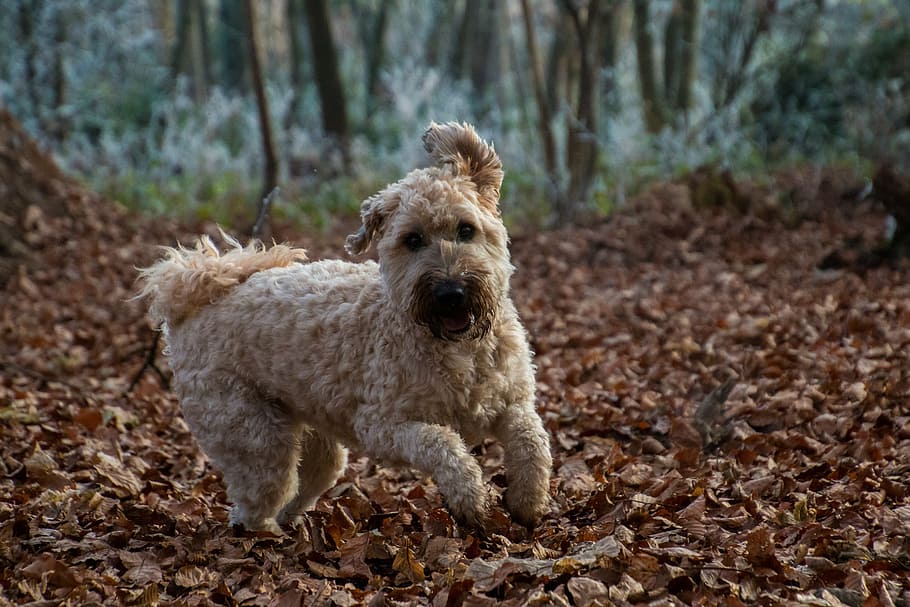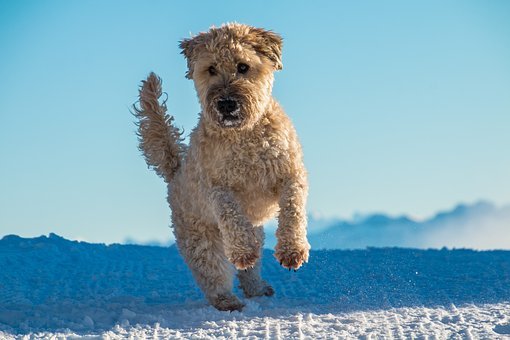Other Names: Irish Soft-Coated Wheaten Terrier and variant spellings: “Soft Coated” and “Softcoated”.
The Soft-coated Wheaten Terrier is a pure breed terrier originating from Ireland. Wheatens typically have one of two coat types: Irish or Heavy (American). The Irish coat is generally silkier and wavier than the Heavy, or American coat, which is thicker and fuller. Wheatens are generally friendly and playful and tend to get along well with children and other dogs.
History
The Wheaten was bred in Ireland for over two hundred years to be an all-purpose farm dog whose duties included herding, watching and guarding livestock, and vermin hunting and killing. They share a common ancestry with the Kerry Blue Terrier and the Irish Terrier but were not owned by the gentry. In Ireland, they were commonly referred to as the “Poor Man’s Wolfhound.” Their tails used to be docked to avoid taxes and were often kept to a specific size.

Despite its long history, the Wheaten was not recognised as a breed in Ireland by the Irish Kennel Club until 1937. In 1943, the British Kennel Club recognised the breed in the UK as well. The first Wheatens were exported to Lydia Vogel in the United States in the 1940s, but serious interest in the breed took another ten years to develop. In the 1970s, the first Wheatens were imported into Australia by Anubis Kennels. In 1973, they were recognised by the American Kennel Club. Recent importation of Irish-style dogs has improved and broadened the gene pool. The American Herding Breed Association (AHBA) accepted the Wheaten in the 1990s at which point members of the breed were allowed to participate in its herding capability tests and trials. Today, Wheatens compete in obedience, agility, and tracking and are occasionally used in animal-assisted therapy as well. The Soft Coated Wheaten Terrier Club of America, Inc. (SCWTCA, Inc.) is a member of the American Kennel Club which protects and advances the interests of the breed and guards against the commercial exploitation. It serves breeders, owners, competition organizers and prospective owners.
Appearance
Puppies have dark coats of red, brown, mahogany or white. Their muzzles and ears may be black or dark brown. The reddish-brown puppy coat gradually grows out to nearly white before maturing into a wheaten-coloured coat as they get older. The adult coat typically matures by 3 years old and may contain black, white, or darker brown “guard” hairs in addition to the lighter wheaten coloured hair. If adults ever have skin injuries, the resulting hair growth (wound hair) will be the dark colour of their puppy coat before it eventually grows out to the wheat colour. It may also come out to a molten chocolate colour, either white or milky coloured fur.
The Soft-coated Wheaten Terrier is a medium-sized dog, which ranges on average from 17 to 20 inches (43 to 51 cm) in height and about 30 to 45 pounds (14 to 20 kg) in weight. The breed has a square structure and is well built. Their soft, silky hair does not shed like most dogs; like human hair and Poodle hair, it keeps growing; they do need trimming and should be brushed and combed once a day to avoid mats. They are very smart dogs and are easy to train. They love people, and they rarely have aggression issues if obtained from a reputable breeder.
The Irish coat tends to be thinner and silkier than the American variety and it has a devoted following in Ireland and Europe. Breeders of the pure Irish type believe this is the original working coat. The coat is not thin – breeders of the Irish type consider the American heavy coat to be “bouffant”, not that of the original working terrier type. There are a few breeders of the Irish type in the US and Canada. In the AKC conformation show ring, the judges do not always accept the Irish type well. The Irish are well received in the UK and Europe. The “Heavy Irish” coat is usually a result of cross-breeding between coat types – American/English coat with an Irish type. The Irish coat still requires daily brushing to stay free of matted hair.
The Wheatens seen in Ireland today are of the same size, shape, and coat texture as those seen and documented well over 100 years ago. Evidence of this can be seen from the famous artwork “The Aran Fisherman’s Drowned Child” by the Irish painter Frederic William Burton.
